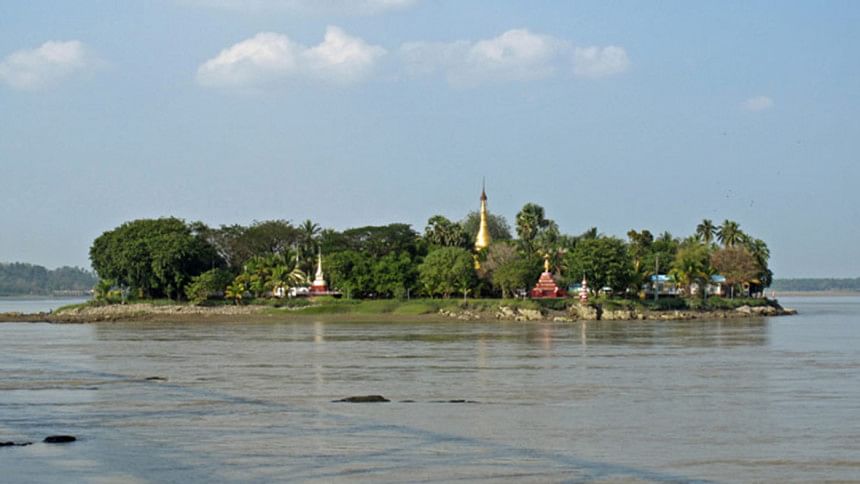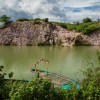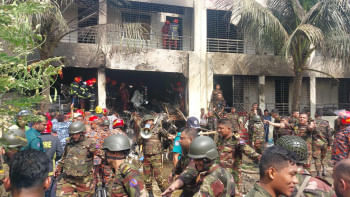Mawlamyine’s “damaged eye”-4

Let's take one of Myanmar's most absorbing boat trips.
The Soe Brothers Guesthouse jointly organises a roundtrip with the Breeze guesthouse in Mawlamyine. The 3-4 hour boat journey costs around K10,000. The boat starts at 12 from one of the jetties of the Thanlyin River.
Board into it and get indulged in whatever comes your way. Palm-thatch huts of pastoral villages to wrinkle-chained limestone scenes; endless rows of Blue Hesper and Coconut palms to the eye-soothing paddy fields; stretched foreshores to lush green hills.
Amidst such idyllic setting live its storytellers. Remember by train one can feel the pulse, but by boat one is within Myanmar's arteries.
To many travellers the life of fishermen may seem rather bucolic and adventurous but the flipside speaks of a different story. Centuries of struggle, hardship and negligence have locked them in an air-tight box. Apart from an essential food source the aquaculture plays an important part in Myanmar's economy. Yet, the productivity of the fisheries is low.
In the southeast, there are over 20 most commonly found fish under the freshwater category. You may not see all but every riverside town is armed with a bustling fish market. It's here where the joys and pains; love and loathe of rural Myanmar is seen, heard and even bought. And oh yes, almost all river by towns have eateries serving barbecued fish. The treasure beneath its muddy waters is explored by the poorly-equipped and ill-fed fishermen. Yet their smile of true content and patience is worth millions.
The over three hours, though monotonous but relaxing journey stopped at Mawlamyine's bustling harbour and a tuk-tuk carried us to another backpacker's den.
However, two often overlooked facts needs be known right before my quest begins. First, it was Mawlamyine and not Rangoon that became the first capital of British-Burma between the years 1826 and 1852. Second, it's Mawlamyine which is the setting of George Orwell's famous 1936 essay-like memoir Shooting an Elephant. The name, however, is spelled Moulmein in the memoirs.
The British writer George Orwell and the former name Burma are two sides of the same coin. However, in the essay the narrator—Orwell, writing in the first person—is a police officer during the time when the anti-European sentiment seemingly reached its peak. After receiving a call to stop an elephant's rampage, the author, armed with a .44 caliber Winchester rifle arrives at Moulmein. Goes to the town where the elephant was last sighted. Entering one of the poorest quarters, he receives conflicting reports and contemplates to leave, guessing the rampage incident to be a hoax. Orwell then sees a village woman chasing away children who were looking at the corpse of a local whom the elephant has trampled and killed. He almost immediately sends an orderly to bring an elephant rifle and, followed by a group of thousands, heads toward the paddy field where the elephant had left behind its resting marks.
The narrator, though reluctant to shoot the elephant, feels compelled by the demand of the local crowd and decides to shoot. He shoots the elephant multiple times and cripples it. He then leaves the wounded beast; unable to bear it's suffering. He later learns that it was stripped, nearly to the bone, within hours. His elderly colleagues agreed that killing the elephant was the best act to have carried out, but the younger ones opined that it was worth more than the Indian it killed. The narrator then wonders if they'll ever understand that he did it "solely to avoid looking a fool."
In Orwell's time Mawlamyine used to be full of elephants employed for hauling logs in the timber firms. That reality may have vanished but leaving behind a dark legacy of Myanmar's colonial past. Several generations of the Orwell family were born and grew up in this city and by the time the writer had arrived here its heydays were over.
Also another famous writer has penned this place, but first things first. Located at the confluence of three rivers, the city was once a wealthy teak port and home to a large British and Anglo-Burmese population. And geographically it is sandwiched between a ridge of pagoda –topped hills and an island-filled estuary. Nevertheless, the lure lies along the viewpoint road.
Yes a series of pagodas awaited to bedazzle me but not with their usual customary features. Not for the Buddha, this writer has reached here because of Kipling and Orwell. Following Kipling's footsteps he strolled along the Kyaikthanlan road and climbed the covered staircase from the east of Upper Main Road. Having passed several monasteries he stood triumphantly at the entrance of the Kyaikthanlan Pagoda aka Kipling's "Old Moulmein Pagoda" which is immortalised in the opening lines of his poem, Mandalay. The lines are: "By the old Moulmein pagoda, lookin' lazy at the sea, there's a Burma girl a-settin', and I know she thinks o' me".
Kipling is believed to have said, that when in Moulmein, he had paid no attention to the pagoda and was struck by a Burmese beauty on the steps.
The pagoda and the sea are exactly where they ought to be but the girl wasn't. The local lass that appeared some 20 minutes later was pretty and not alone , holding a guy's hand which Kipling surely wouldn't have liked.
This is also Mawlamyine's oldest and tallest pagoda with a tiled staircase. Many pagodas can offer many angular views of sunrise and sunsets but this offers a charm of a view of the islands of the Thanlyin estuary. Like a heritage site it's an attractive up and down walkway connecting four pagodas which are: The Kyaikthanlin , Mahamuni Paya , Seindon Mibaya Kyaung and the U Zina pagoda.
Not by kings or emperors The Mahamuni Paya was built with donations given by a wealthy local lady. Inside its central shrine is a replica of the Buddha at Mandalay's Mahamuni Paya – the densely mirrored interior is glitzy. Flanked by curved elephant tasks, this Buddha statue, too, is painted in gold. The interior changes its aura and light in accord with daylight.
At dusk the interior was getting gloomy. Bits and pieces of mirrors glowed. The plush and flamboyant look began to be replaced by a much sombre and shadowy look. The heavily ornate door facing my back screeched mildly and an aged monk signalled that it was time to leave. A faded orange hue had pierced through the spire on top. The Buddha was about to rest in isolation. He was left alone.
Out of old artefacts what's left are some original tiles hand painted with peacocks and a brilliant powder-blue interior. A downhill staircase in the west of this pagoda will take you to the resting place of the fourth princess who is also the youngest daughter of King Thibaw, the last king of the Konbaung Dynasty of Burma. But this writer got overwhelmed at the opposite end's century old royal court called Seindon Mibaya Kyaung. This awfully dilapidated place has a hall containing gold teak reliefs and curved elephant tasks. The cobweb festooned replica throne looks like coming straight out of a medieval horror movie. A little farther left pitched-path snakes down to a monastery.
The fourth largest city of Myanmar is not densely populated, nearly half its boundary line overlooks the Salween River and it is also home to three wonderfully built old mosques in the north. Like Sittwe its strand road running along the river bank has lot to offer in terms of shopping, eating and watching. The vestige of colonial atmosphere is not stored in any particular place but rather scattered around the city.
For a few intriguing spots the city is the perfect base for exploring its surroundings. And since intrigue is the topic what could be better than the remains of the Second World War's infamous 'death railway' aka Burma-Siam railway, located some 65 kilometres south from the city centre, not far from the Thai border. The line was built by the Japanese Imperial Army at the height of the Second World War to transport troops and supplies from Thailand to Burma. Cutting through the Tenasserim hills with primitive tools and at the cost of more than 100,000 lives the 420-km long railway was completed in just fourteen months. A little south from the Thanbyuzayat clock tower stands a steam locomotive sitting on a section of the old track to commemorate the railway. A nearby war cemetery contains the graves of some four thousand commonwealth and Dutch soldiers, most of them died during the construction and air raids over the bridge.
However, the railway was operational for less than two years. The rotunda shape of the memorial is similar to our one in Comilla. Almost all graves are marked with bronze-plaques. The quiet peaceful south Myanmar is home to many dark legacies of the last Great War. i kept pondering and right then a foreign visitor caught my attention . Remember that young German lady climbing the Mt.Zwegabin with this writer? She stood at a distance less than 100 metres.
Backpack travelling may be tough but often open doors to share stirring feelings with complete strangers. I couldn't help, said hello to her and shared a similar experience of visiting the Dachau concentration camp, two years earlier. Then we parted and never saw her again. Getting here, even from Mawlamyine was tough and expensive. Shared taxis are recommended for those inspired to visit this place.
Before the road back to Yangon let's share a legacy. The name deriving from Mot-Mua-Lum means "one eye destroyed". Legend has it that , once a Mon king had a powerful third eye in the centre of his forehead with which he could see what was happening in neighbouring kingdoms. When the daughter of one of the neighbouring kings was given in marriage to the three-eyed king she managed to destroy her husband's third eye. The Burmese name "Mawlamyine" is believed to be a somewhat distorted meaning of the Mon name.
Whatever the legend be, Mawlamyine is dangerous for three-eyed creatures.
My tale is racing towards its end and also this traveller needs to reach Yangon by taking one last train journey. Compared to the city's size, commuters and population Mawlamyine has a colossal train station, similar to that of an airport building. No crowds and almost free of touts. The over ten hour journey will reach Yangon before dusk.
You, by now know, how trains are like in this country so get set to endure the bumpy ride.
The writer is a journalist and a keen traveller.

 For all latest news, follow The Daily Star's Google News channel.
For all latest news, follow The Daily Star's Google News channel. 








Comments